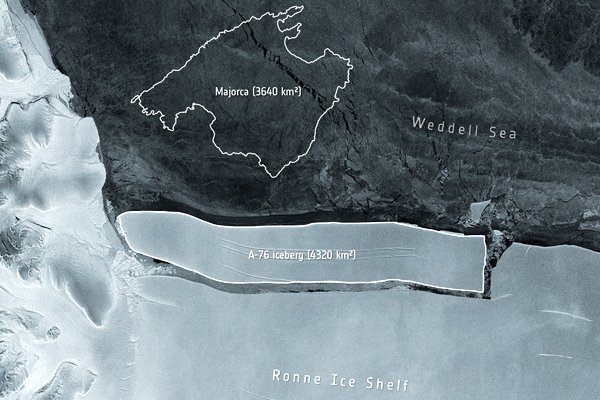The world’s largest iceberg has broken off from an ice shelf in Antarctica and is floating through the Weddell Sea, the European Space Agency said.
Called A-76 and roughly the shape of Manhattan but more than 70 times bigger, it was picked up on satellite images and is “currently the largest berg in the world”, the ESA said Wednesday.
The iceberg is around 170 kilometers (105 miles) long and 25 kilometers wide, with an area of 4,320 square kilometers, slightly larger than the Spanish island of Majorca.
The berg, which broke off the western side of the Ronne Ice Shelf, was originally spotted by the British Antarctic Survey and confirmed using images from the Copernicus satellite.
It takes the place as the world’s largest from the A-23A iceberg — approximately 3,880 sq km in size – which is also in the Weddell Sea.
In November last year, what was then the world’s largest iceberg appeared to be on a collision course with a remote South Atlantic island home to thousands of penguins and seals, threatening to impede their ability to gather food.
The iceberg, known as A68a, had also broken off from the Larsen Ice Shelf, which has warmed faster than any other part of Earth’s southernmost continent.
A68a, which was 160 kilometers long and 48 kilometers across, broke apart before it could cause any damage to the abundant wildlife in the British Overseas Territory of South Georgia.
Earth’s average surface temperature has gone up by one degree Celsius since the 19th century, enough to increase the intensity of droughts, heatwaves, and tropical cyclones.
But the air over Antarctica has warmed more than twice that much.
This was followed by the breakup of the nearby Wilkins Ice Shelf in 2008 and 2009.
A process known as hydrofracturing was likely the main culprit in both cases, earlier research has shown.
Hydrofracturing occurs when water – which is heavier than ice – pours through cracks in the surface of ice shelves caused by surface warming, violently forcing the fractures to zip open, causing an iceberg to break off.
Icebergs are traditionally named after the Antarctic quadrant in which they were originally detected, then a sequential number.
If they break apart more letters are added to differentiate the fragments.
Subscribe to our Youtube Channel:


.jpeg&w=60&q=100&h=60)





.jpeg&w=60&q=100&h=60)





